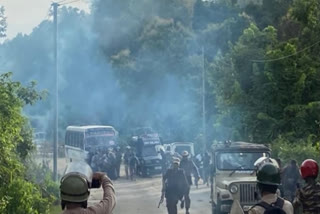New Delhi: Located in Assam's Cachar district just bordering Mizoram, Lailapur may be a lovely sounding name. But on Monday morning, it was anything but that when bullets flew all around in the one-horse town in the foothills of the Lushai hills. At least six Assam policemen were gunned down while about 70 were injured.
While Assam CM Himanta Biswa Sarma tweeted that the Mizoram Police had used light machine guns (LMGs) on the Assam Police, there were social media videos showing Mizo civilians brandishing automatic weapons with prohibited bores, at least one fitted with telescopic sights. It raised questions on the active involvement of civilians who were armed with deadly but illegal weapons.
The central paramilitary forces were soon rushed in to assume control of the area and stand as the buffer between the two-state police forces. But the story of high unease between the Bengali-speaking people on the Assam side of the inter-state border and the Mizos on the other side is not new.
Notifications
Not clearly demarcated, the Assam-Mizoram border is unclear at many stretches with the Lailapur-Vairengte being one of the flashpoints. At the heart of the disagreement are two legislations. A 1875 notification demarcated the Lushai Hills from the plain of Cachar while another notification in 1933 divided the Lushai Hills-Manipur boundary. While Mizoram emphasizes adherence to the 1875 rule, Assam insists on the 1933 notification.
What adds to the complexity is the nature of the concept of tribal ownership of land that uses geographical features like mountains, rivers and forests as landmarks to lay claim to traditional ownership. This is at odds with the modern concept of ownership that insists on papers and legalities.
Population Mix
For a long period of time, the forested Lailapur-Vairengte border remained free of serious disturbances but increasing population pressure on the scarce land resources took a toll.
The Mizos insist that Lailapur’s population has soared in recent years with most of the newer additions suspected to be illegal immigrants from Bangladesh and Rohingyas from Myanmar who had escaped their country to escape persecution.
With a spike in population, erstwhile forests were being gradually cleared and homesteads raised by the new settlers leading to the occupation of buffer areas that were left untouched in the recent past setting the stage for an imminent confrontation.
